Accounting & Finance Assignment .
VerifiedAdded on 2023/05/28
|12
|1738
|490
AI Summary
This assignment covers topics like effective interest rate, annuity, dividend imputation, CAPM model, holding period returns, standard deviation and more in Accounting & Finance.
Contribute Materials
Your contribution can guide someone’s learning journey. Share your
documents today.
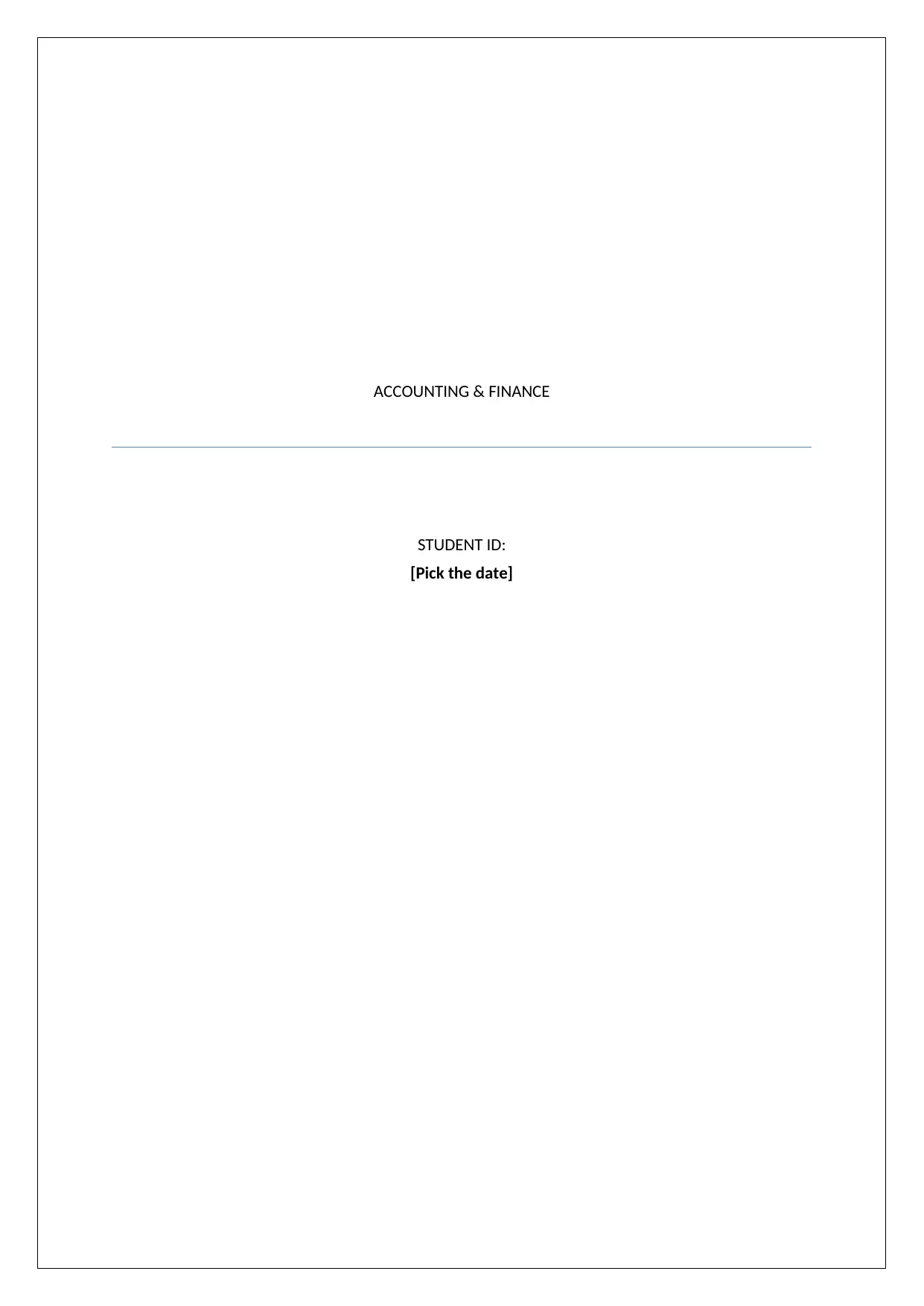
ACCOUNTING & FINANCE
STUDENT ID:
[Pick the date]
STUDENT ID:
[Pick the date]
Secure Best Marks with AI Grader
Need help grading? Try our AI Grader for instant feedback on your assignments.

Question 1
a) (i) In order to decide as to which payment option should Jayne choose, it is imperative to
compute the effective interest rate for both the options and then choose the cheaper option.
EAR (4.55% p.a. compounded weekly) = (1+(4.55/5200))52 – 1 = 4.65%
With regards to the other option, the nominal rate is 4.75% and when the same would be
adjusted for nominal payment, then the effective annual rate would be much higher. As a
result, the interest rate of 4.55% p.a. compounded weekly would be preferred.
(ii) The formula for the principal repayment instalment is indicated below.
Instalment = P*R*(1+R)N/([1+R)N -1]
For the given question, P = $ 500,000, R = (4.55%/52) per week, Instalment = $ 1,000, N = ?
1000 = 500000*(4.55%/52)*(1+(4.55%/52))N/(1+(4.55%/52))N -1)
Solving the above, we get N = 657.85 weeks
b) (i) Let the total contribution required from the couple every month be $ X. The future
value of this annuity for 18 years at the end of the 18 year period would be $ 200,000. The
relevant formula for future value of annuity is indicated below.
For the given question, p = $ X, r= (2.5%/12) = 0.002083, n = 18*12 = 216 months, FV = $
200,000
Hence, 200,000 = P ((1.002083)216-1)/0.002083
Solving the above, we get P = $ 734.11
a) (i) In order to decide as to which payment option should Jayne choose, it is imperative to
compute the effective interest rate for both the options and then choose the cheaper option.
EAR (4.55% p.a. compounded weekly) = (1+(4.55/5200))52 – 1 = 4.65%
With regards to the other option, the nominal rate is 4.75% and when the same would be
adjusted for nominal payment, then the effective annual rate would be much higher. As a
result, the interest rate of 4.55% p.a. compounded weekly would be preferred.
(ii) The formula for the principal repayment instalment is indicated below.
Instalment = P*R*(1+R)N/([1+R)N -1]
For the given question, P = $ 500,000, R = (4.55%/52) per week, Instalment = $ 1,000, N = ?
1000 = 500000*(4.55%/52)*(1+(4.55%/52))N/(1+(4.55%/52))N -1)
Solving the above, we get N = 657.85 weeks
b) (i) Let the total contribution required from the couple every month be $ X. The future
value of this annuity for 18 years at the end of the 18 year period would be $ 200,000. The
relevant formula for future value of annuity is indicated below.
For the given question, p = $ X, r= (2.5%/12) = 0.002083, n = 18*12 = 216 months, FV = $
200,000
Hence, 200,000 = P ((1.002083)216-1)/0.002083
Solving the above, we get P = $ 734.11
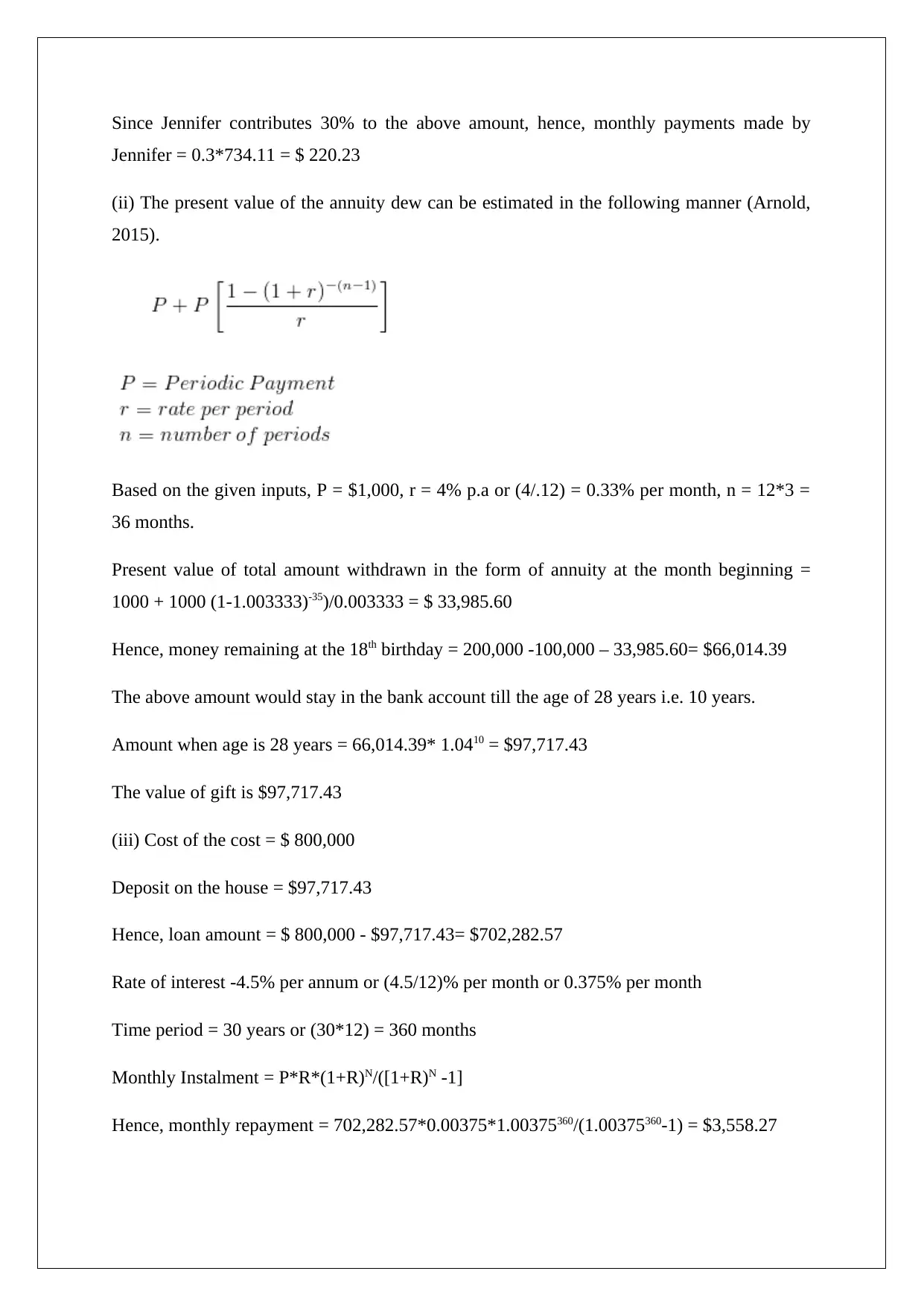
Since Jennifer contributes 30% to the above amount, hence, monthly payments made by
Jennifer = 0.3*734.11 = $ 220.23
(ii) The present value of the annuity dew can be estimated in the following manner (Arnold,
2015).
Based on the given inputs, P = $1,000, r = 4% p.a or (4/.12) = 0.33% per month, n = 12*3 =
36 months.
Present value of total amount withdrawn in the form of annuity at the month beginning =
1000 + 1000 (1-1.003333)-35)/0.003333 = $ 33,985.60
Hence, money remaining at the 18th birthday = 200,000 -100,000 – 33,985.60= $66,014.39
The above amount would stay in the bank account till the age of 28 years i.e. 10 years.
Amount when age is 28 years = 66,014.39* 1.0410 = $97,717.43
The value of gift is $97,717.43
(iii) Cost of the cost = $ 800,000
Deposit on the house = $97,717.43
Hence, loan amount = $ 800,000 - $97,717.43= $702,282.57
Rate of interest -4.5% per annum or (4.5/12)% per month or 0.375% per month
Time period = 30 years or (30*12) = 360 months
Monthly Instalment = P*R*(1+R)N/([1+R)N -1]
Hence, monthly repayment = 702,282.57*0.00375*1.00375360/(1.00375360-1) = $3,558.27
Jennifer = 0.3*734.11 = $ 220.23
(ii) The present value of the annuity dew can be estimated in the following manner (Arnold,
2015).
Based on the given inputs, P = $1,000, r = 4% p.a or (4/.12) = 0.33% per month, n = 12*3 =
36 months.
Present value of total amount withdrawn in the form of annuity at the month beginning =
1000 + 1000 (1-1.003333)-35)/0.003333 = $ 33,985.60
Hence, money remaining at the 18th birthday = 200,000 -100,000 – 33,985.60= $66,014.39
The above amount would stay in the bank account till the age of 28 years i.e. 10 years.
Amount when age is 28 years = 66,014.39* 1.0410 = $97,717.43
The value of gift is $97,717.43
(iii) Cost of the cost = $ 800,000
Deposit on the house = $97,717.43
Hence, loan amount = $ 800,000 - $97,717.43= $702,282.57
Rate of interest -4.5% per annum or (4.5/12)% per month or 0.375% per month
Time period = 30 years or (30*12) = 360 months
Monthly Instalment = P*R*(1+R)N/([1+R)N -1]
Hence, monthly repayment = 702,282.57*0.00375*1.00375360/(1.00375360-1) = $3,558.27
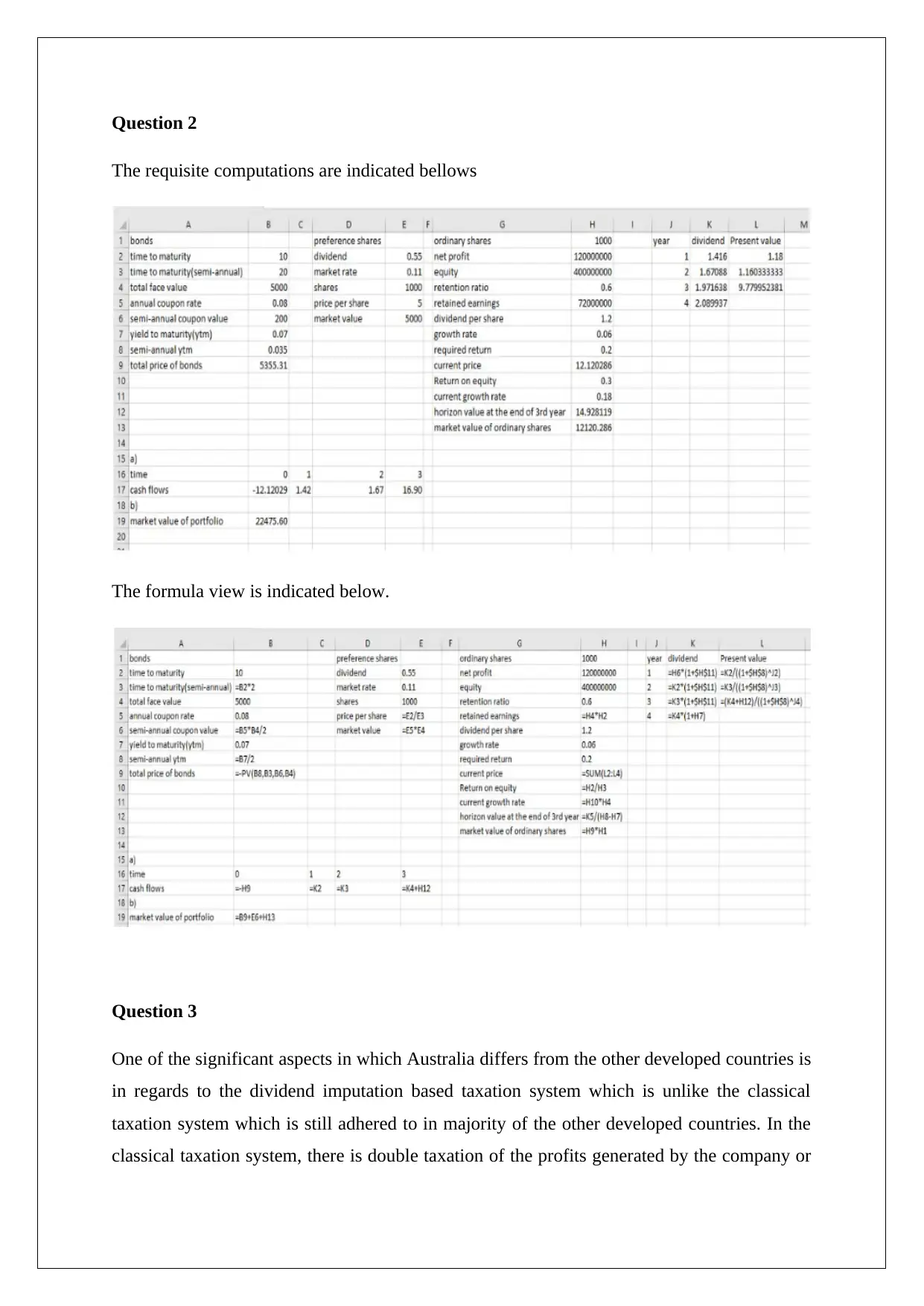
Question 2
The requisite computations are indicated bellows
The formula view is indicated below.
Question 3
One of the significant aspects in which Australia differs from the other developed countries is
in regards to the dividend imputation based taxation system which is unlike the classical
taxation system which is still adhered to in majority of the other developed countries. In the
classical taxation system, there is double taxation of the profits generated by the company or
The requisite computations are indicated bellows
The formula view is indicated below.
Question 3
One of the significant aspects in which Australia differs from the other developed countries is
in regards to the dividend imputation based taxation system which is unlike the classical
taxation system which is still adhered to in majority of the other developed countries. In the
classical taxation system, there is double taxation of the profits generated by the company or
Secure Best Marks with AI Grader
Need help grading? Try our AI Grader for instant feedback on your assignments.
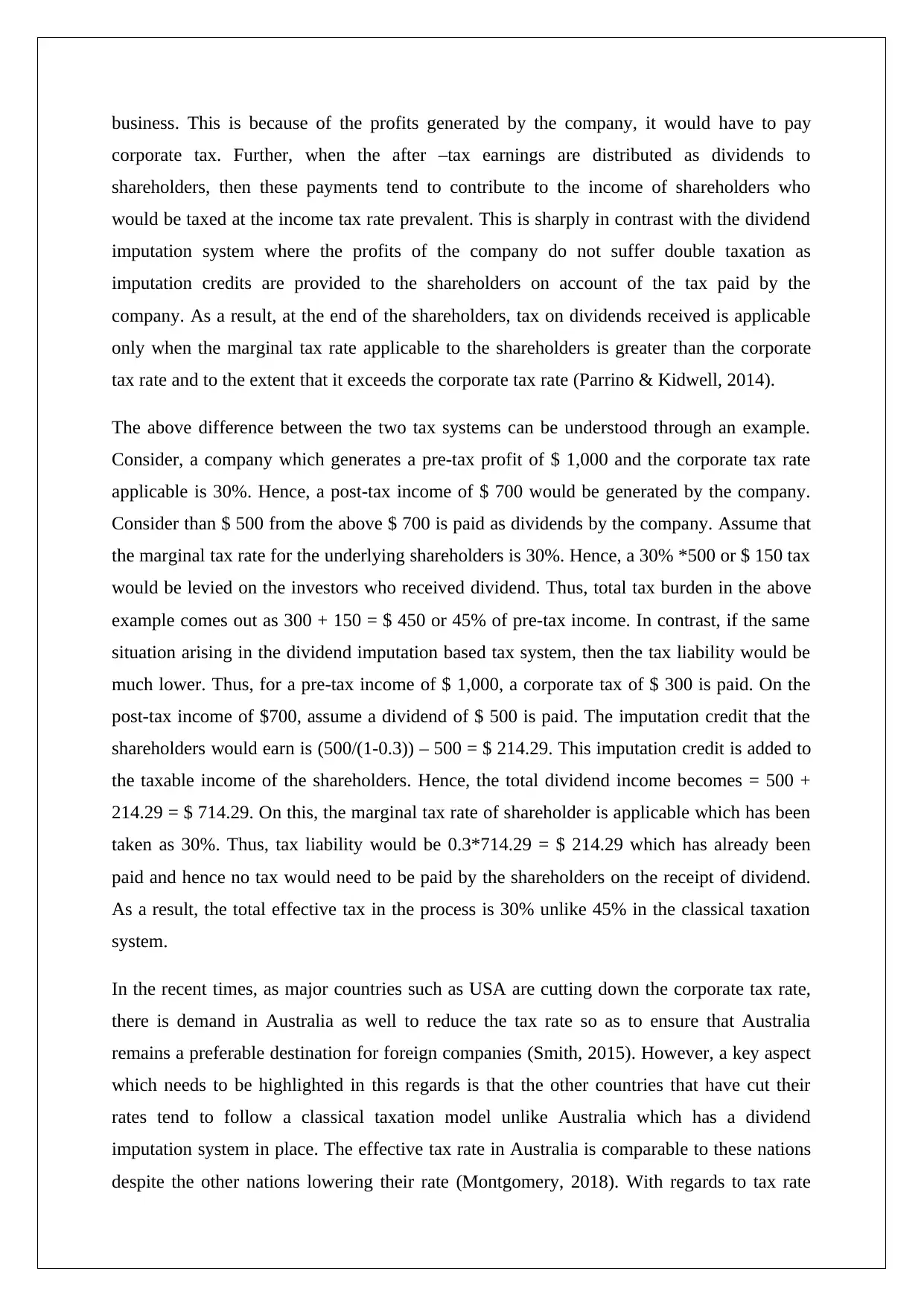
business. This is because of the profits generated by the company, it would have to pay
corporate tax. Further, when the after –tax earnings are distributed as dividends to
shareholders, then these payments tend to contribute to the income of shareholders who
would be taxed at the income tax rate prevalent. This is sharply in contrast with the dividend
imputation system where the profits of the company do not suffer double taxation as
imputation credits are provided to the shareholders on account of the tax paid by the
company. As a result, at the end of the shareholders, tax on dividends received is applicable
only when the marginal tax rate applicable to the shareholders is greater than the corporate
tax rate and to the extent that it exceeds the corporate tax rate (Parrino & Kidwell, 2014).
The above difference between the two tax systems can be understood through an example.
Consider, a company which generates a pre-tax profit of $ 1,000 and the corporate tax rate
applicable is 30%. Hence, a post-tax income of $ 700 would be generated by the company.
Consider than $ 500 from the above $ 700 is paid as dividends by the company. Assume that
the marginal tax rate for the underlying shareholders is 30%. Hence, a 30% *500 or $ 150 tax
would be levied on the investors who received dividend. Thus, total tax burden in the above
example comes out as 300 + 150 = $ 450 or 45% of pre-tax income. In contrast, if the same
situation arising in the dividend imputation based tax system, then the tax liability would be
much lower. Thus, for a pre-tax income of $ 1,000, a corporate tax of $ 300 is paid. On the
post-tax income of $700, assume a dividend of $ 500 is paid. The imputation credit that the
shareholders would earn is (500/(1-0.3)) – 500 = $ 214.29. This imputation credit is added to
the taxable income of the shareholders. Hence, the total dividend income becomes = 500 +
214.29 = $ 714.29. On this, the marginal tax rate of shareholder is applicable which has been
taken as 30%. Thus, tax liability would be 0.3*714.29 = $ 214.29 which has already been
paid and hence no tax would need to be paid by the shareholders on the receipt of dividend.
As a result, the total effective tax in the process is 30% unlike 45% in the classical taxation
system.
In the recent times, as major countries such as USA are cutting down the corporate tax rate,
there is demand in Australia as well to reduce the tax rate so as to ensure that Australia
remains a preferable destination for foreign companies (Smith, 2015). However, a key aspect
which needs to be highlighted in this regards is that the other countries that have cut their
rates tend to follow a classical taxation model unlike Australia which has a dividend
imputation system in place. The effective tax rate in Australia is comparable to these nations
despite the other nations lowering their rate (Montgomery, 2018). With regards to tax rate
corporate tax. Further, when the after –tax earnings are distributed as dividends to
shareholders, then these payments tend to contribute to the income of shareholders who
would be taxed at the income tax rate prevalent. This is sharply in contrast with the dividend
imputation system where the profits of the company do not suffer double taxation as
imputation credits are provided to the shareholders on account of the tax paid by the
company. As a result, at the end of the shareholders, tax on dividends received is applicable
only when the marginal tax rate applicable to the shareholders is greater than the corporate
tax rate and to the extent that it exceeds the corporate tax rate (Parrino & Kidwell, 2014).
The above difference between the two tax systems can be understood through an example.
Consider, a company which generates a pre-tax profit of $ 1,000 and the corporate tax rate
applicable is 30%. Hence, a post-tax income of $ 700 would be generated by the company.
Consider than $ 500 from the above $ 700 is paid as dividends by the company. Assume that
the marginal tax rate for the underlying shareholders is 30%. Hence, a 30% *500 or $ 150 tax
would be levied on the investors who received dividend. Thus, total tax burden in the above
example comes out as 300 + 150 = $ 450 or 45% of pre-tax income. In contrast, if the same
situation arising in the dividend imputation based tax system, then the tax liability would be
much lower. Thus, for a pre-tax income of $ 1,000, a corporate tax of $ 300 is paid. On the
post-tax income of $700, assume a dividend of $ 500 is paid. The imputation credit that the
shareholders would earn is (500/(1-0.3)) – 500 = $ 214.29. This imputation credit is added to
the taxable income of the shareholders. Hence, the total dividend income becomes = 500 +
214.29 = $ 714.29. On this, the marginal tax rate of shareholder is applicable which has been
taken as 30%. Thus, tax liability would be 0.3*714.29 = $ 214.29 which has already been
paid and hence no tax would need to be paid by the shareholders on the receipt of dividend.
As a result, the total effective tax in the process is 30% unlike 45% in the classical taxation
system.
In the recent times, as major countries such as USA are cutting down the corporate tax rate,
there is demand in Australia as well to reduce the tax rate so as to ensure that Australia
remains a preferable destination for foreign companies (Smith, 2015). However, a key aspect
which needs to be highlighted in this regards is that the other countries that have cut their
rates tend to follow a classical taxation model unlike Australia which has a dividend
imputation system in place. The effective tax rate in Australia is comparable to these nations
despite the other nations lowering their rate (Montgomery, 2018). With regards to tax rate
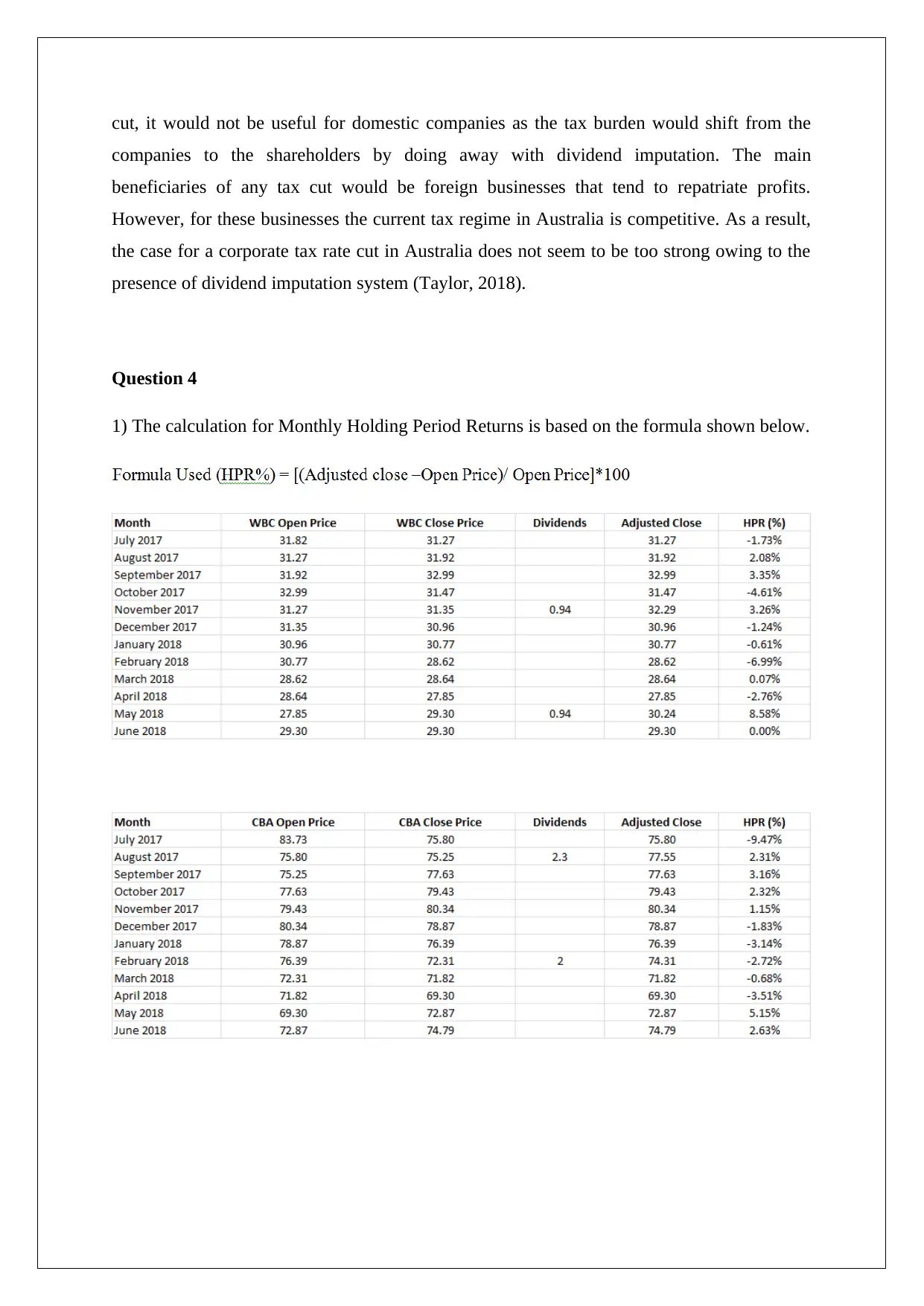
cut, it would not be useful for domestic companies as the tax burden would shift from the
companies to the shareholders by doing away with dividend imputation. The main
beneficiaries of any tax cut would be foreign businesses that tend to repatriate profits.
However, for these businesses the current tax regime in Australia is competitive. As a result,
the case for a corporate tax rate cut in Australia does not seem to be too strong owing to the
presence of dividend imputation system (Taylor, 2018).
Question 4
1) The calculation for Monthly Holding Period Returns is based on the formula shown below.
companies to the shareholders by doing away with dividend imputation. The main
beneficiaries of any tax cut would be foreign businesses that tend to repatriate profits.
However, for these businesses the current tax regime in Australia is competitive. As a result,
the case for a corporate tax rate cut in Australia does not seem to be too strong owing to the
presence of dividend imputation system (Taylor, 2018).
Question 4
1) The calculation for Monthly Holding Period Returns is based on the formula shown below.
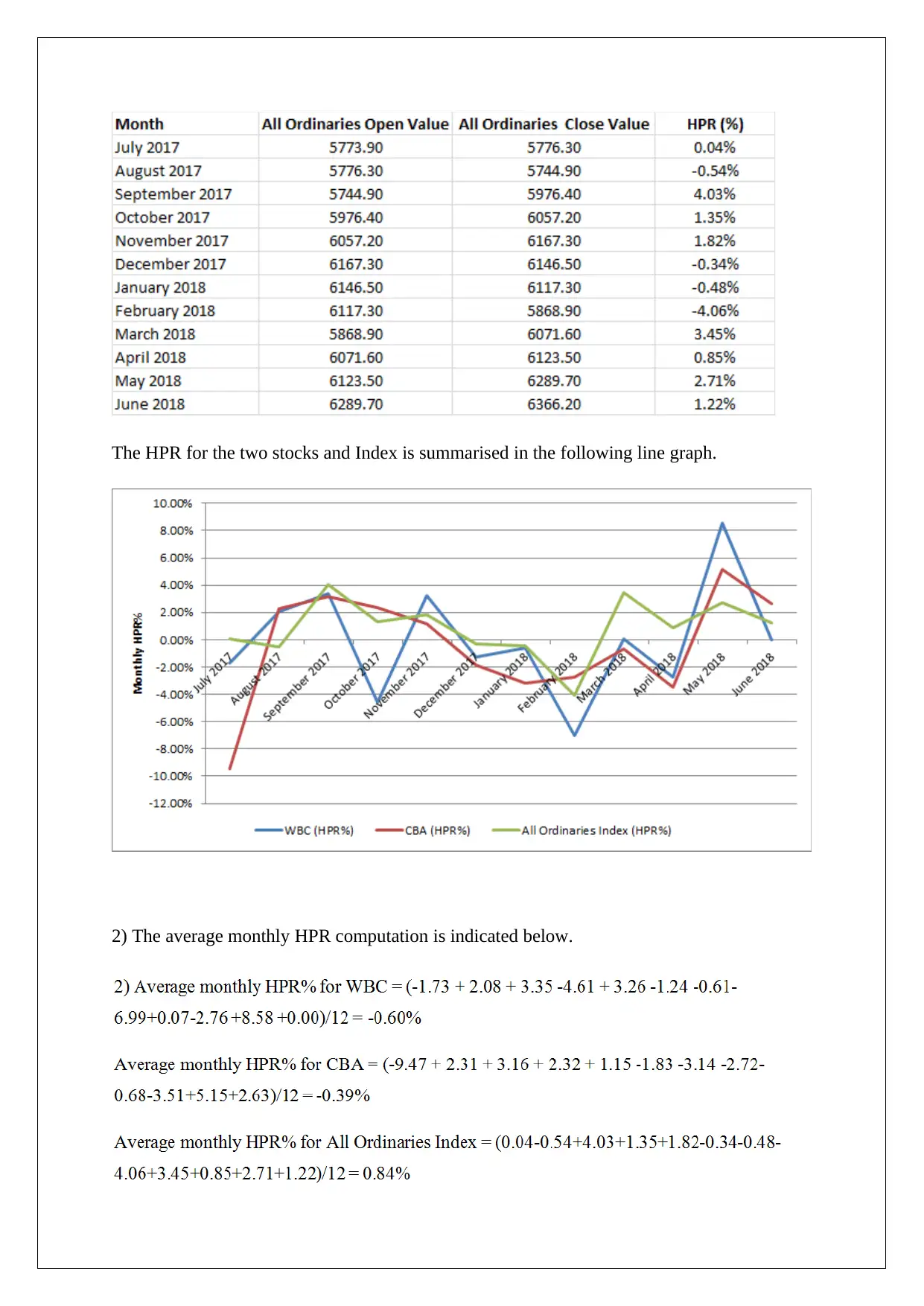
The HPR for the two stocks and Index is summarised in the following line graph.
2) The average monthly HPR computation is indicated below.
2) The average monthly HPR computation is indicated below.
Paraphrase This Document
Need a fresh take? Get an instant paraphrase of this document with our AI Paraphraser
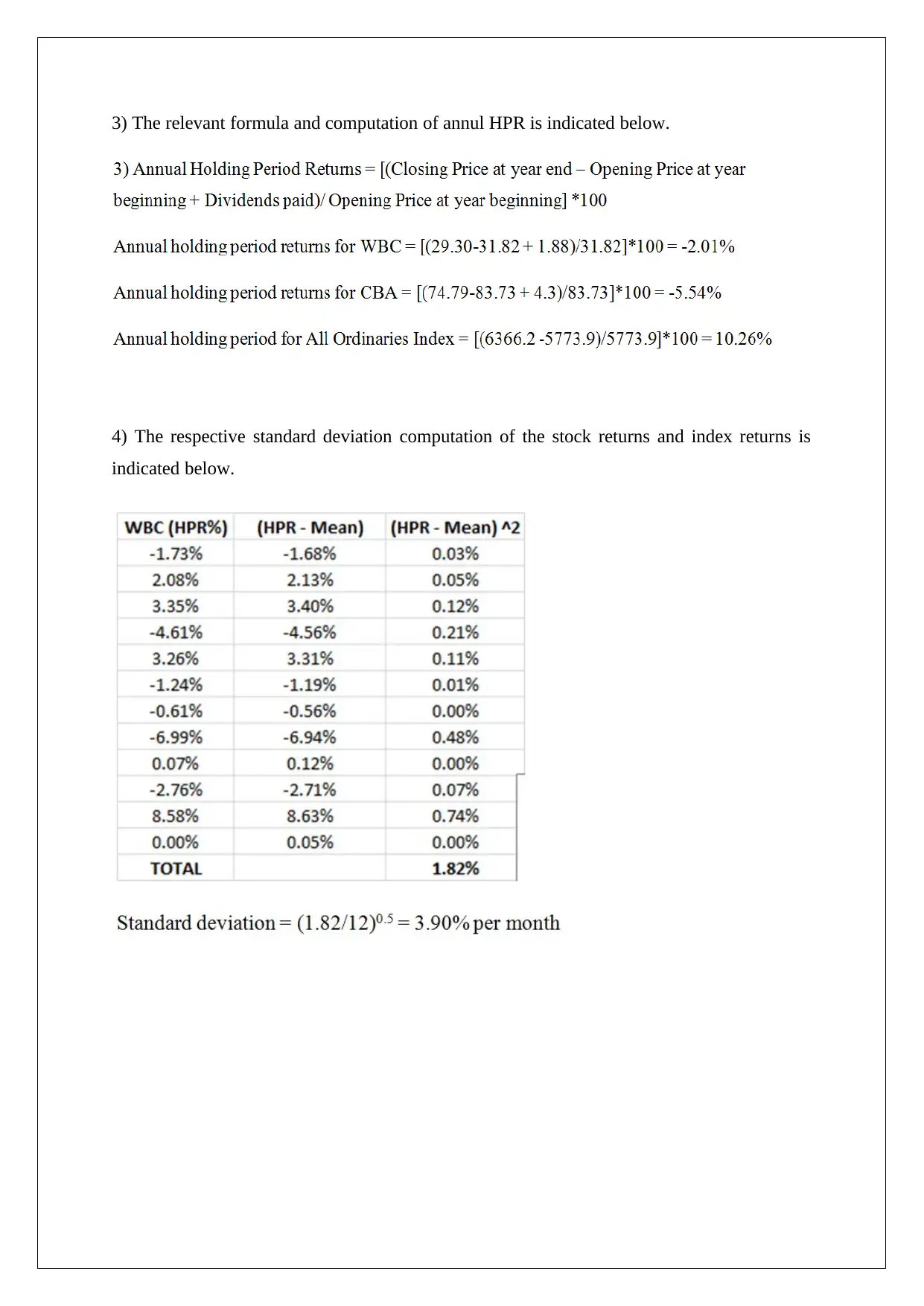
3) The relevant formula and computation of annul HPR is indicated below.
4) The respective standard deviation computation of the stock returns and index returns is
indicated below.
4) The respective standard deviation computation of the stock returns and index returns is
indicated below.

5) The scatter plot is as highlighted as follows.
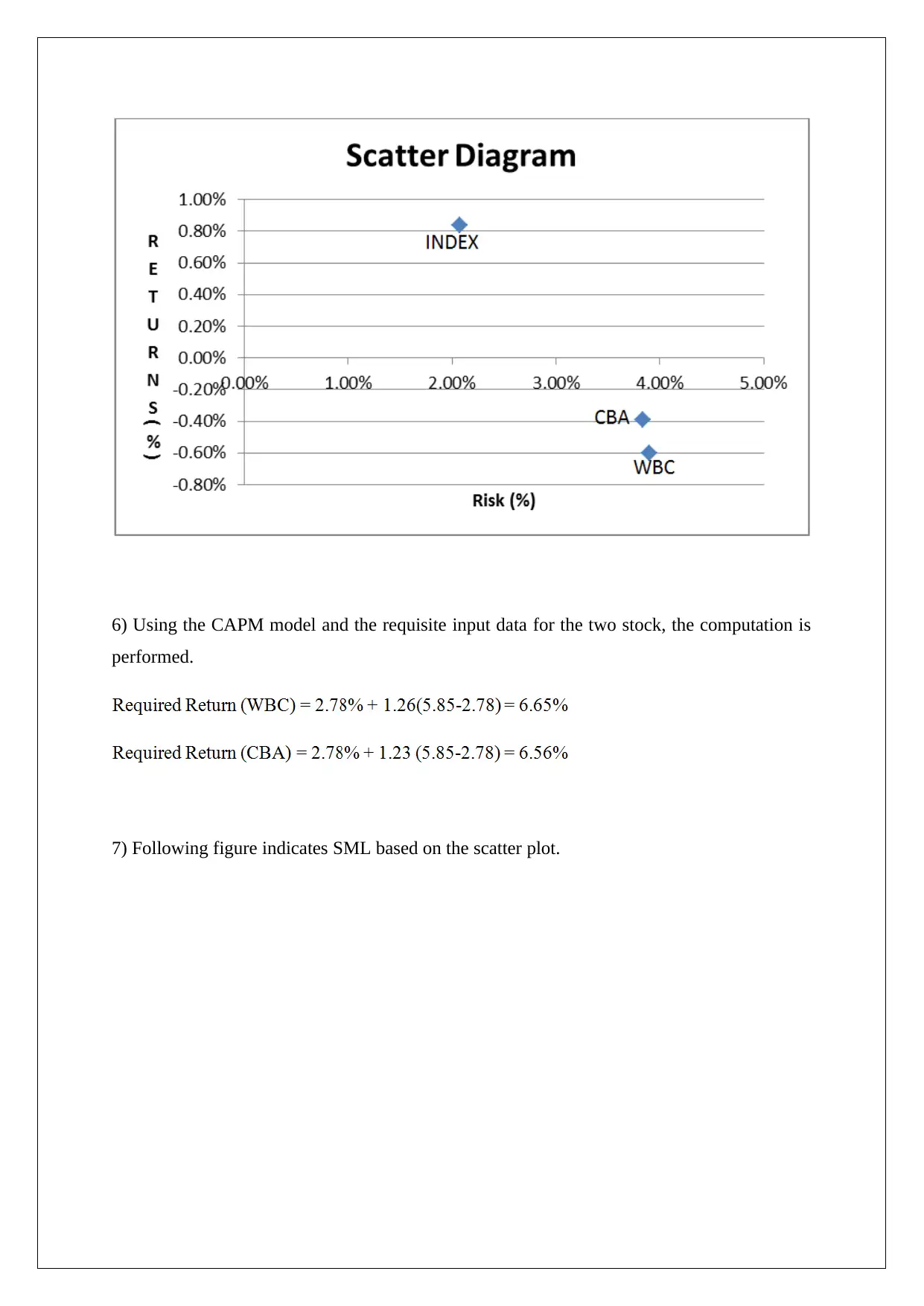
6) Using the CAPM model and the requisite input data for the two stock, the computation is
performed.
7) Following figure indicates SML based on the scatter plot.
performed.
7) Following figure indicates SML based on the scatter plot.
Secure Best Marks with AI Grader
Need help grading? Try our AI Grader for instant feedback on your assignments.
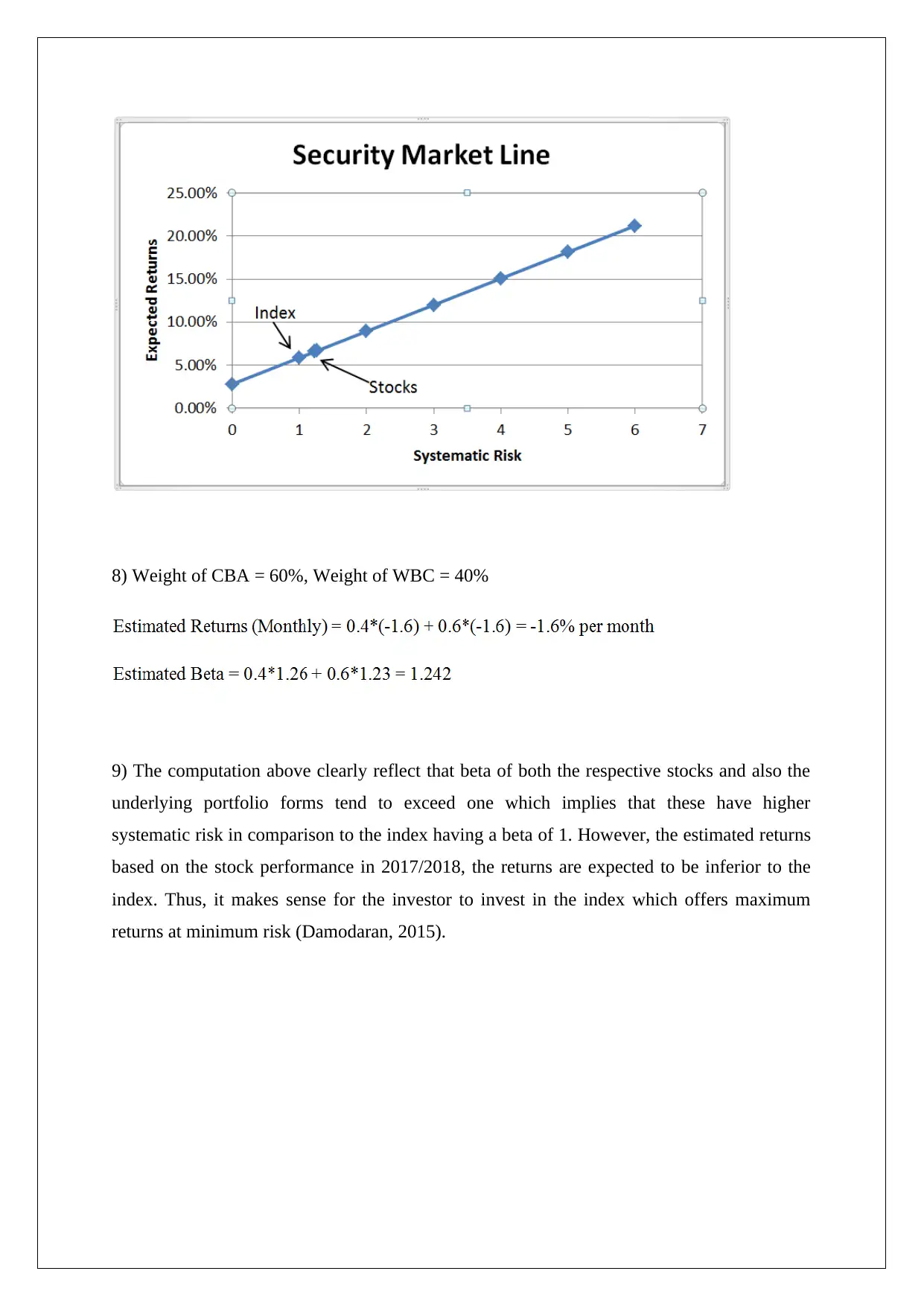
8) Weight of CBA = 60%, Weight of WBC = 40%
9) The computation above clearly reflect that beta of both the respective stocks and also the
underlying portfolio forms tend to exceed one which implies that these have higher
systematic risk in comparison to the index having a beta of 1. However, the estimated returns
based on the stock performance in 2017/2018, the returns are expected to be inferior to the
index. Thus, it makes sense for the investor to invest in the index which offers maximum
returns at minimum risk (Damodaran, 2015).
9) The computation above clearly reflect that beta of both the respective stocks and also the
underlying portfolio forms tend to exceed one which implies that these have higher
systematic risk in comparison to the index having a beta of 1. However, the estimated returns
based on the stock performance in 2017/2018, the returns are expected to be inferior to the
index. Thus, it makes sense for the investor to invest in the index which offers maximum
returns at minimum risk (Damodaran, 2015).
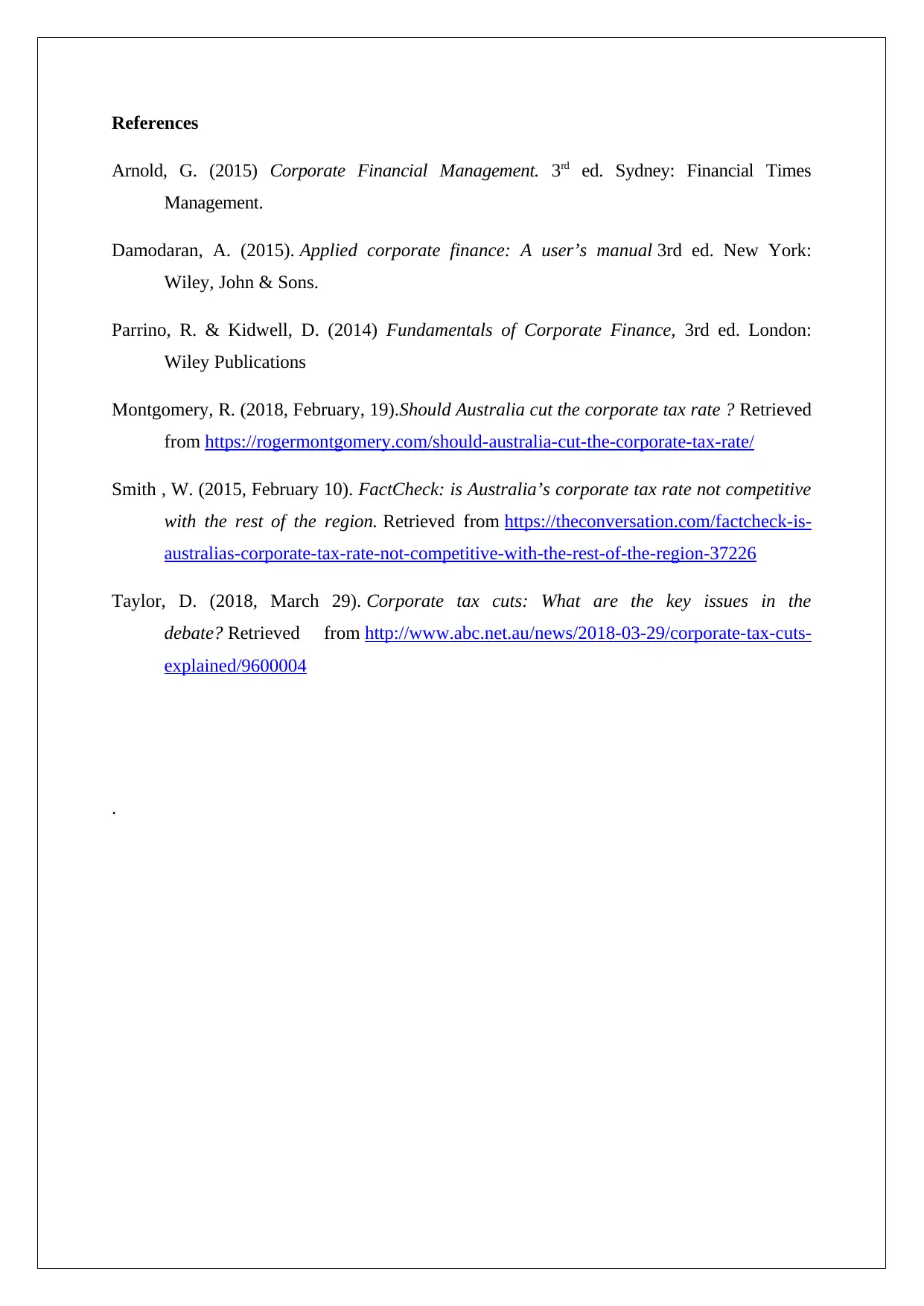
References
Arnold, G. (2015) Corporate Financial Management. 3rd ed. Sydney: Financial Times
Management.
Damodaran, A. (2015). Applied corporate finance: A user’s manual 3rd ed. New York:
Wiley, John & Sons.
Parrino, R. & Kidwell, D. (2014) Fundamentals of Corporate Finance, 3rd ed. London:
Wiley Publications
Montgomery, R. (2018, February, 19).Should Australia cut the corporate tax rate ? Retrieved
from https://rogermontgomery.com/should-australia-cut-the-corporate-tax-rate/
Smith , W. (2015, February 10). FactCheck: is Australia’s corporate tax rate not competitive
with the rest of the region. Retrieved from https://theconversation.com/factcheck-is-
australias-corporate-tax-rate-not-competitive-with-the-rest-of-the-region-37226
Taylor, D. (2018, March 29). Corporate tax cuts: What are the key issues in the
debate? Retrieved from http://www.abc.net.au/news/2018-03-29/corporate-tax-cuts-
explained/9600004
.
Arnold, G. (2015) Corporate Financial Management. 3rd ed. Sydney: Financial Times
Management.
Damodaran, A. (2015). Applied corporate finance: A user’s manual 3rd ed. New York:
Wiley, John & Sons.
Parrino, R. & Kidwell, D. (2014) Fundamentals of Corporate Finance, 3rd ed. London:
Wiley Publications
Montgomery, R. (2018, February, 19).Should Australia cut the corporate tax rate ? Retrieved
from https://rogermontgomery.com/should-australia-cut-the-corporate-tax-rate/
Smith , W. (2015, February 10). FactCheck: is Australia’s corporate tax rate not competitive
with the rest of the region. Retrieved from https://theconversation.com/factcheck-is-
australias-corporate-tax-rate-not-competitive-with-the-rest-of-the-region-37226
Taylor, D. (2018, March 29). Corporate tax cuts: What are the key issues in the
debate? Retrieved from http://www.abc.net.au/news/2018-03-29/corporate-tax-cuts-
explained/9600004
.
1 out of 12
Related Documents
Your All-in-One AI-Powered Toolkit for Academic Success.
+13062052269
info@desklib.com
Available 24*7 on WhatsApp / Email
![[object Object]](/_next/static/media/star-bottom.7253800d.svg)
Unlock your academic potential
© 2024 | Zucol Services PVT LTD | All rights reserved.



